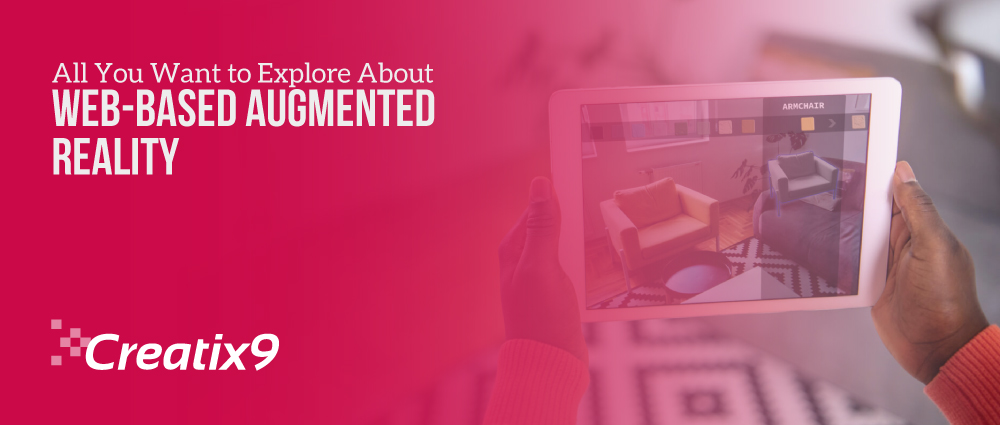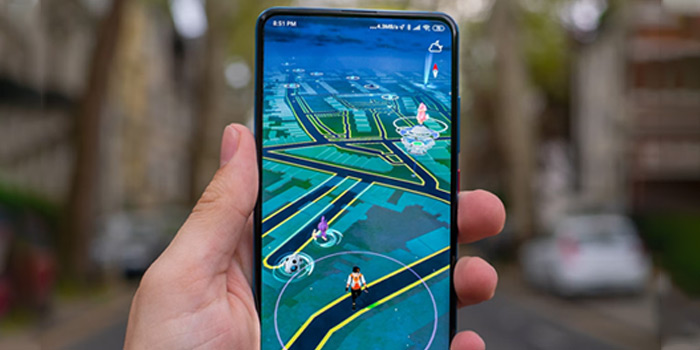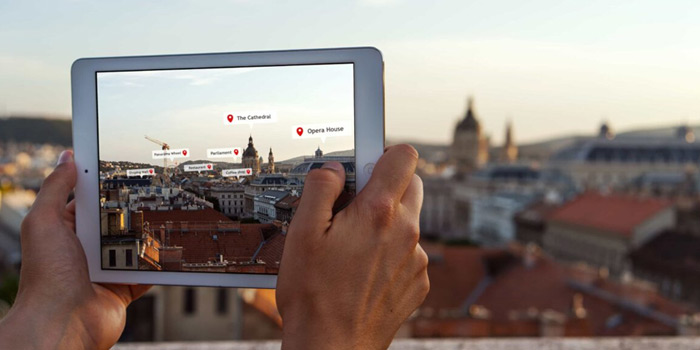
Web-based augmented reality (WebAR) is a technology where a web browser can see and interact with augmented reality (AR) content, unlike traditional AR experiences, which can be accessed directly from a browser instead of needing users to download and install specific software. With WebAR, you can expand your audience, benefit from usability, and offer a seamless AR experience.
Anyone with a web-enabled device can access AR material without downloading or installing any software. Web based augmented reality experiences are typically easier to construct than desktop augmented reality applications, making them more affordable yet adaptable. As well as that WebAR allows you to share through a URL, which makes it viral and allows for marketing to a larger audience.
The critical advantage of WebAR over traditional solutions is that it has a far broader user base than other AR applications. The WebAR footprint is growing so quickly because of the seamless user experience and limitless reach.
So here in this blog, Creatix9 US, the top AR app development company offering top-notch software development services, will go through how it works, its features and its advantages. We will also discuss how Web-based AR differ from App-based AR. Let’s Begin.
How Does Web AR Function?
 WebAR depends on sensors being positioned and tracked in your physical environment when utilized on mobile devices. The delivery of target and object identification, interactivity, videos, animated 3D objects, and more is made possible by the integration of computer vision and sensors in augmented reality web app experiences.
WebAR depends on sensors being positioned and tracked in your physical environment when utilized on mobile devices. The delivery of target and object identification, interactivity, videos, animated 3D objects, and more is made possible by the integration of computer vision and sensors in augmented reality web app experiences.
Currently, using WebAR on mobile devices enables you to benefit from all of this technology’s advantages, and the future is much more exciting. Developers now have the opportunity to add even more exciting features in the future thanks to the addition of new intriguing technologies like magnetometers and accelerometers in mobile browsers.
Examine WebAR’s four key features, which are listed below and better understand how it functions.
Seven Degrees of Freedom (SDoF)
 SDoF is a simple idea that, in some ways, refers to the freedom of motion of a rigid body in three dimensions. The mobile browser keeps track of the model’s axis of location and orientation while using WebAR to interact with 3D pictures. In the end, SDoF enforces total control over the direction and movement of the 3D image, which is necessary for a proper WebAR experience.
SDoF is a simple idea that, in some ways, refers to the freedom of motion of a rigid body in three dimensions. The mobile browser keeps track of the model’s axis of location and orientation while using WebAR to interact with 3D pictures. In the end, SDoF enforces total control over the direction and movement of the 3D image, which is necessary for a proper WebAR experience.
Camera-Assisted Streaming
The mobile camera on your mobile device needs to offer a perspective and field of vision for it to function correctly. This idea is essential for integrating filters, and web-based 3D augmented reality objects into a physical environment. Because of this, camera streaming is a critical idea in WebAR.
Knowledge of a Scene
If you want to use WebAR, you’ll need a good grasp of your real-world environment to place 3D objects and augmentations there. This is why your mobile device has to map a surface and determine the amount of light and distance to give WebAR experiences.
A Contemporary Content Management System (CMS)
Remember that contemporary WebAR solutions make use of cutting-edge Content Management Systems. Specific tools and platforms use cloud-based technology, making it simple to trigger augmented reality (AR) events. These triggers can be anything from QR codes to markers to specific places. Once you’ve stored your triggers in the cloud-based CMS, you’ll have the opportunity to integrate interactive content that you can set in line with your project’s objectives.
App-Based AR vs. WebAR
Web-based AR and app-based AR are the two categories of AR and differ in functionality. App-based augmented reality (AR) relies on an app to deliver AR experiences; you need to download the app to use it. Web-based AR, often known as augmented reality without an app, uses a web browser to deliver AR experiences without downloading.
Regarding functionality, AR applications surpass WebAR solutions because they use the superior computer vision capabilities offered by ARCore and ARKit. As everything has a cost, developing AR apps requires more resources, and as a result, additional testing on many platforms and operating systems is necessary.
Compared to AR apps, WebAR can reach millions of devices because of how widely accessible and far-reaching it can be. Despite being less technologically advanced, Web-based solutions offer a cutting-edge AR experience without needing an app.
Advantages of WebAR
The benefits of WebAR are infinite and include anything from quick deployment and no need for further content download to smart updates and numerous integrations. Overall, the most notable advantages of WebAR are:
- Huge reach, enabling you to use millions of devices in your marketing campaign.
- App-free experience available as AR in the browser, removing any entry hurdles.
- Unlimited engagement with your audience, significantly increasing your brand’s recognition among the general public.
- Fast deployment is attained primarily through the app-less experience, and compatibility with well-known web browsers eventually helps to increase reach even further.
- 4x dwell duration increase in contrast to non-AR experiences and mobile videos.
While AR applications certainly have their advantages, WebAR is quickly gaining acceptance because of the aforementioned advantages.
Characteristics of WebAR
 You need to review each of WebAR’s key features individually to comprehend them better. The WebAR solutions’ contemporary characteristics are promising, even though their functionality is somewhat constrained compared to traditional AR applications. Consider a few of the main features that WebAR offers to its users.
You need to review each of WebAR’s key features individually to comprehend them better. The WebAR solutions’ contemporary characteristics are promising, even though their functionality is somewhat constrained compared to traditional AR applications. Consider a few of the main features that WebAR offers to its users.
Before moving to the features, you can contact Creatix9 US, the top web-based AR and IoT app development company in the USA, if you intend to launch an AR web-based or asp based or both facility for your client for your business. We offer the top software development services around the US.
AR Facial Tracking
With AR face tracking, a mobile device can follow a person’s face as it moves. It is mainly used to produce lifelike 3D models, apply AR filters, and provide augmentations that can be adjusted to manage the AR experience.
Taking the Background Out
Eliminating undesired components from the backdrop can involve editing, hiding, or altogether erasing them. The background removal tool is highly configurable thanks to WebAR technologies, which enable you to complete it in a few clicks.
Mapping and localization simultaneously (SLAM)
Simultaneous Localization and Mapping (SLAM) technology uses feature points to comprehend the physical world. In its entirety, SLAM enables WebAR applications to identify 3D objects and scenes. Furthermore, it instantly tracks the world as a whole and offers the opportunity to overlay digital augmentations.
Geographic Positioning
Users can position virtual objects in the virtual environment using AR geo-locational positioning. Usually, this is accomplished by tracking the user’s location and using augmented reality to overlay the virtual object on top of the actual environment. You can achieve this by manually arranging the material on a map or using GPS data. You can add a video or audio clip to the material and a 3D model of a building.
Track Objects
Tracking an object in the real world in an augmented reality setup requires a computer vision algorithm. By anchoring virtual things to actual objects in the real world, object tracking enables the creation of augmented reality experiences that let users interact with virtual objects more naturally. Gaming, education, and industrial jobs like assembly and maintenance are just a few of the uses for object tracking.
Track An Image
Regarding picture tracking, this browser’s AR function offers options to recognize 2D images. Displaying digital information such as films, slideshows, panoramas, sound, text, or 3D animations causes detection. Many technologies, including optical character recognition, computer vision, and fiducial markers, can be used for image tracking.
Ways to Introduce People to Web AR
By fusing the virtual and real worlds, WebAR offers an immersive experience. Looking at your phone’s camera will give you an accurate representation of the outside world.
As a result, the 3D or other computer-generated information can seamlessly integrate with a real-world setting. AR Web content’s presentation, however, differs from that of AR applications. There are a few methods that enable bringing users to that location without major obstacles because it needs to lead them to a specific web page, including:
- Brands can use social media to transform their marketing strategies by going for content powered by WebAR. Users must tap on a shared link or advertisement to begin a WebAR experience on social media.
- Another well-known method for introducing consumers to WebAR is sharing QR codes. You will automatically enter the AR experience when you point your device’s camera at the code.
- You can also use SMS messaging, which your clients can access and use to launch the WebAR experience through the SMS link.
- You can email your intended audience a direct link if necessary. To share your WebAR experience, feel free to embed it on your emails, websites, or social network posts.
- Television advertising is another way to spread the word about your WebAR experience. Provide your customers with a means to activate your WebAR product while they watch TV in their homes.
- Including banner advertisements in your WebAR campaign will help it succeed by giving your target audience an immersive and engaging full-scale advertising trip.
- Make it simple by using one of the URL-shortening providers to create a shortened link. By doing this, users can manually type the address into their browser because they will remember it.
- If you prefer to activate the WebAR experience using an already-existing augmented reality website, try utilizing the Call-to-Action (CTA) button.
You can see that there are many methods that users can use to activate their own WebAR experiences. Choose it, then begin implementing it using one of the WebAR frameworks based on how well it serves your business needs.
Conclusion
With the help of WebAR technology, your business could significantly improve the effectiveness of your marketing or activation plans. It would help if you used the appropriate frameworks and technologies to meet your organizational goals because WebAR is becoming more common and technologically sophisticated.
You can get advice on how to build a unique solution from the beginning from the knowledgeable staff of WebAR specialists at the AR app development called Creatix9 US.

